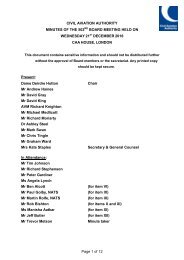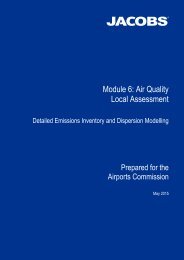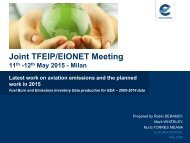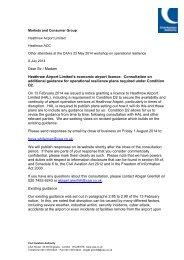NATS-Annual-Report-2015
NATS-Annual-Report-2015
NATS-Annual-Report-2015
You also want an ePaper? Increase the reach of your titles
YUMPU automatically turns print PDFs into web optimized ePapers that Google loves.
<strong>Annual</strong> <strong>Report</strong> and Accounts <strong>2015</strong> | <strong>NATS</strong> Holdings Limited<br />
Financial Statements 145<br />
Notes forming part of the<br />
consolidated accounts<br />
(continued)<br />
28. Retirement benefit schemes (continued)<br />
The scheme assets do not include any investments in the equity or debt instruments of group companies or any property or other assets<br />
used by the group.<br />
Virtually all equity and debt instruments have quoted prices in active markets. Investments are well diversified, such that the failure of<br />
any single investment would not have a material impact on the overall level of assets. A large portion of the assets consist of equities and<br />
bonds, although the scheme also invests in property, cash and investment (private equity and hedge) funds.<br />
<strong>NATS</strong> and Trustees implemented a Liability Driven Investment (LDI) programme in 2012 in order to hedge the impact of changes in<br />
inflation and interest rates on the value of the scheme’s obligations, which are sensitive to inflation and movements in yields in the<br />
gilt market. The strategy includes establishing trigger levels which define the rates of interest and inflation rates at which hedging<br />
transactions will be executed. In addition, and as an acceleration of the existing strategy, <strong>NATS</strong> and Trustees agreed during 2014 to<br />
increase the level of hedging of interest rates and inflation to 50%, as measured on the Trustee funding basis. Swap transactions are<br />
executed with carefully scrutinised banks and collateral is provided in the form of index-linked gilts to protect against the unlikely event of<br />
default by a counterparty bank.<br />
At <strong>NATS</strong>’ request, Trustees have also considered further de-risking over time to protect the scheme from the impact of volatility in the<br />
value of return-seeking assets. This would involve progressively converting from return-seeking assets into hedging assets to increase<br />
the level of matching of the scheme’s liabilities. As changing the mix of assets changes the returns achieved, this would impact on<br />
contributions payable. Before changing this strategy, <strong>NATS</strong> and Trustees are likely to consult with CAA on the implications for customers.<br />
The strategy will aim to maintain an appropriate balance between the potential impact on contributions and the reduction in volatility of<br />
return-seeking assets, and therefore reduced investment risk.<br />
Derivative instruments are used by investment managers to reduce risk or gain exposure to investment classes without the requirement<br />
to hold the underlying investment. Trustees monitor derivative positions to ensure that, when combined with the underlying physical<br />
position, the aggregate falls within specified investment guidelines.<br />
The actual return on scheme assets for the year ended 31 March <strong>2015</strong> was £496.6m (2014: £244.5m).<br />
Financial<br />
Statements






